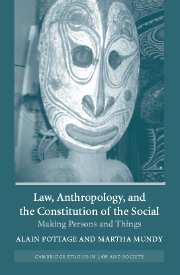Book contents
- Frontmatter
- Contents
- Notes on contributors
- 1 Introduction: the fabrication of persons and things
- 2 Res Religiosae: on the categories of religion and commerce in Roman law
- 3 Scientific objects and legal objectivity
- 4 Legal fabrications and the case of ‘cultural property’
- 5 Ownership or office? A debate in Islamic Hanafite jurisprudence over the nature of the military ‘fief’, from the Mamluks to the Ottomans
- 6 Gedik: a bundle of rights and obligations for Istanbul artisans and traders, 1750–1840
- 7 Losing (out on) intellectual resources
- 8 Re-visualising attachment: an anthropological perspective on persons and property forms
- 9 Our original inheritance
- Bibliography
- Index
1 - Introduction: the fabrication of persons and things
Published online by Cambridge University Press: 12 July 2009
- Frontmatter
- Contents
- Notes on contributors
- 1 Introduction: the fabrication of persons and things
- 2 Res Religiosae: on the categories of religion and commerce in Roman law
- 3 Scientific objects and legal objectivity
- 4 Legal fabrications and the case of ‘cultural property’
- 5 Ownership or office? A debate in Islamic Hanafite jurisprudence over the nature of the military ‘fief’, from the Mamluks to the Ottomans
- 6 Gedik: a bundle of rights and obligations for Istanbul artisans and traders, 1750–1840
- 7 Losing (out on) intellectual resources
- 8 Re-visualising attachment: an anthropological perspective on persons and property forms
- 9 Our original inheritance
- Bibliography
- Index
Summary
Each of the contributions to this book addresses the question of how legal techniques fabricate persons and things. In exploring that question, and in asking just what ‘fabrication’ means, each chapter focuses on a specific historical, social, or ethnographic context. Given that these contexts, and the modes of institutional or ritual action which they disclose, are quite varied, this book does not aim to provide a general theoretical account of the fabrication of persons and things in law. Indeed, the term ‘fabrication’ is chosen precisely because it suggests modes of action which are lodged in rich, culturally-specific, layers of texts, practices, instruments, technical devices, aesthetic forms, stylised gestures, semantic artefacts, and bodily dispositions. Each contribution shows how, in a given social, historical, or ethnographic context, elements of this repertoire are mobilised by legal techniques of personification and reification. The specific character of these modes of action would be lost in a general theory of law as an agent of ‘social construction’. Yet, diverse as they may be, our approaches to the question of legal fabrication are brought together as resources for reflection upon a specific institutional predicament. In Western legal systems, persons and things are now problems rather than presuppositions. One could point to technology, and biotechnology in particular, as the main factor here, but there are other reasons for the implosion of the old legal division between persons and things.
- Type
- Chapter
- Information
- Law, Anthropology, and the Constitution of the SocialMaking Persons and Things, pp. 1 - 39Publisher: Cambridge University PressPrint publication year: 2004
- 40
- Cited by



